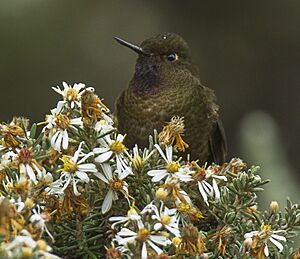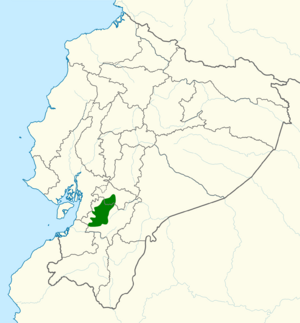Violet-throated metaltail facts for kids
Quick facts for kids Violet-throated metaltail |
|
|---|---|
 |
|
| Conservation status | |
| Scientific classification | |
| Genus: |
Metallura
|
| Species: |
baroni
|
 |
|
The violet-throated metaltail (Metallura baroni), also known locally as metalura gorjivioleta, is a special type of hummingbird found only in Ecuador. It's an endangered bird, which means there aren't many left in the wild. These tiny birds are part of a group called "coquettes" and are known for their beautiful, shiny feathers.
Contents
About the Violet-throated Metaltail
How Scientists Classify This Bird
Scientists use a system called taxonomy to group living things. The violet-throated metaltail is a unique species. It's the only one of its kind in its specific group, meaning it doesn't have any subspecies. Long ago, some thought it was a type of fiery-throated metaltail. This bird was named after Oscar Theodor Baron, who collected specimens.
What Does It Look Like?
The violet-throated metaltail is a small bird, about 10 to 11 cm (3.9 to 4.3 in) long. That's about the length of your hand! Males usually weigh between 4.3 to 4.5 g (0.15 to 0.16 oz), and females are a bit lighter, from 3.9 to 5 g (0.14 to 0.18 oz).
Both male and female birds have a medium-sized, straight, black beak. The adult male has dark olive green feathers on its back and belly. Its throat has a bright, shiny purple-violet patch called a gorget. Its tail is slightly forked and looks iridescent (shimmering) violaceous sky blue on top. The underside of its tail is a glittering yellow-green.
Female birds also have dark olive green on their upper parts. Their throat patch is not as bright as the male's. Their chest and belly are whitish-gray with olive green spots. The tips of their outer tail feathers are whitish underneath. Young birds look similar to adult females.
Where the Violet-throated Metaltail Lives
Its Home in Ecuador
This special hummingbird lives only on the Cajas Plateau in Ecuador. This plateau is west of the city of Cuenca, Ecuador. It stretches across parts of the Azuay and Cañar provinces.
What Its Habitat Is Like
The violet-throated metaltail prefers to live at the edges of elfin forests and Polylepis woodlands. It also likes the nearby páramo grasslands. Its favorite places have large rocks covered with plants like bromeliads, Ericaceae (heather family), ferns, and mosses. It usually lives at high elevations, between 3,000 and 3,900 m (9,800 and 12,800 ft) above sea level. Once, it was seen as low as 1,900 m (6,200 ft).
How the Violet-throated Metaltail Behaves
Movement and Travel
Scientists are not sure if the violet-throated metaltail moves around much. It's possible that it moves to different elevations during certain seasons, but more research is needed to confirm this.
What It Eats
The violet-throated metaltail eats nectar from flowers. It hovers in the air while feeding, collecting nectar from many different types of flowering plants found in its habitat. Male birds often protect their feeding areas from other hummingbirds.
Reproduction and Life Cycle
It's believed that these hummingbirds build their nests between November and February. One nest that was found looked like a slipper without a heel. It was made from moss, small twigs, and wool. The female bird lays two white eggs and takes care of them. The exact time it takes for the eggs to hatch or for the chicks to grow is not yet known.
Its Calls and Sounds
The violet-throated metaltail has a unique call. It's described as "a descending series of 3–5 squeaky notes, followed by several jumbled ones, 'trsee-seee-seee-sew..trr-tsee-tse-tsew..trr-tsee-tse-tsew'." This sound might be a song or a call it uses when chasing other birds.
Why This Bird Is Endangered
The IUCN (International Union for Conservation of Nature) first listed the violet-throated metaltail as "Threatened." Then, in 1994, it was changed to "Vulnerable." Since 2000, it has been listed as "Endangered." This means it faces a very high risk of disappearing forever.
There are fewer than 1,700 adult violet-throated metaltails left, and their numbers are still going down. This bird lives in El Cajas National Park and a smaller nearby area called the Río Mazán reserve. However, even inside the national park, its home is in danger. People sometimes burn the land to create new pastures for animals, which destroys the bird's habitat. Protecting these areas is very important to help the violet-throated metaltail survive.


